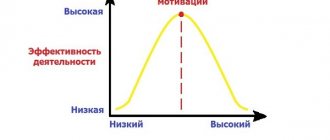McClelland's theory of motivation is widely popular. It is based on the study of the influence of needs on motivational processes in the consciousness of an individual. Motivation can awaken hidden potential in a person, push him to take decisive action, and make him move towards success.
David McClelland's motivation theory is used in the process of organizing employee work. The result of applying the theory is an increase in labor efficiency in the company.
Next, let's look at what David McClelland was based on when creating the theory and how it helps build effective activities.
Need for achievement
Otherwise, this need can be called the need for efficiency. This means that employees strive for ways of doing that work that are more efficient than they had before. That is, employees have a need to do their work easier and faster than they do now or did before.
Moreover, there are employees for whom this need is clearly expressed. In McClelland's theory, such employees need tasks that require them to challenge themselves, overcome difficulties, that is, such employees need to be given the opportunity to achieve results - this will become the strongest motivation for such a person.
Dominant motivations
McClelland says that regardless of our gender, culture or age, we have three motivations, and one of them is dominant. This dominant motivation is largely influenced by our life experiences.
McClelland identified three main motivations:
- Need for Achievement:
People whose drive is the need for achievement are focused on setting and achieving challenging goals, and they are able to take risks to achieve their goals. In addition, they love to receive constant feedback on their achievements. They usually prefer to work alone. - Need for Affiliation:
People whose dominant motivation is the need to belong always want to belong to a group. It is more important for them to cooperate than to compete. In addition, they do not like risky challenges or uncertain situations. They tend to agree with everything the rest of the group says or wants to do. - Need for Power:
People with this dominant motivation want to take control and influence others. They enjoy winning arguments, competing, and being recognized and respected.
Conclusion from McClelland's theory
McClelland believed that these three types of needs, or rather their combination, determine the motivation of any employee. Knowing the needs of an employee, you can build a motivation system for him, and also understand what tasks are best assigned to him.
Thus, the theory of acquired needs can be widely used in practice (see some examples). To do this, you need to clearly define the needs (or rather, a combination of them) for employees or groups of employees (departments, departments).
Comparative theories
Another theory that is similar to McClelland's theory is Sirota's three-factor theory, which also proposes three motivators: fairness, achievement, and camaraderie.
They are enthusiastic about starting a new job and motivated to succeed. But over time, bad company policies or any other condition makes workers lose motivation. However, McClelland's theory states that motivation does matter to employees.
If you find an error, please select a piece of text and press Ctrl+Enter.
Power
The name of this motivator speaks for itself - such an employee is motivated by the presence of power. He wants to control other members of the group and is motivated by this opportunity. This is the type of person who will be successful in a competitive environment and will not shy away from it.
If you have several people on your staff who fit this description perfectly, it may be best to let them “fight,” that is, let them compete to bring out the best in them every day.
Unlike a person who simply wants to be successful, this type of employee wants to lead a strong team and be recognized for their efforts.
Position plays a big role in keeping this type of person motivated, so a promotion will be a great motivator.
Someone who is motivated by power may be ideal for certain roles in an organization and yet perform poorly at other tasks. It is important that this type of person is placed in the right position and environment for his long-term productivity.
Motivation to achieve and avoid failures
McClelland's theory divides human activity into 2 different types, based on the focus of motivation, which in each specific situation have their own disadvantages and advantages:
- Achievement motivation is characteristic of people who set tasks with an average level of risk, where the likelihood of success depends as much as possible on them, and not on external factors. This concept is developed thanks to outside encouragement. As a result, a person is not afraid to show creative initiative and activity, to fully realize his potential.
- The motivation to avoid failures forces a person to choose goals with minimal risk, where the share of development is small (the lower the stakes, the smaller the gain). At the same time, people can consciously take on those tasks in which most of the result does not depend in any way on their personal abilities and contributions. This life position is developed when punishment is used to regulate behavior and activity. As a result, their frequent use leads to inhibition of activity, caution, and stiffness. Such people tend to limit their ideas, give up at the slightest obstacle, and behave without initiative.
Knowledge of these features helps not only in personnel management, but also in successfully motivating employees. By understanding one's strengths and weaknesses, a person can learn to resist manipulation and develop active achievement traits using positive reinforcement.
McClelland's theory of acquired needs
Home Favorites Random article Educational New additions Feedback FAQ⇐ PreviousPage 4 of 5Next ⇒
It presents Maslow’s highest levels of needs in its own way, but without hierarchy. David McClelland believed that people have three inherent needs: power, success and belonging.
The need for power is expressed as a desire to influence other people. Within Maslow's hierarchical structure, the need for power falls somewhere between the needs for esteem and self-expression. People with a need for power most often manifest themselves as outspoken and energetic people, not afraid of confrontation and seeking to defend their original positions. They are often good speakers and require increased attention from others. Management very often attracts people with a need for power, since it provides many opportunities to express and realize it.
People with a need for power are not necessarily power-hungry careerists in the negative and most commonly used meaning of these words.
The need for success also lies somewhere in between the need for esteem and the need for self-expression. This need is satisfied not by proclaiming the person's success, but by the process of bringing the work to a successful conclusion.
People with a high need for success take moderate risks, like situations in which they can take personal responsibility for finding a solution to a problem, and want specific rewards for the results they achieve.
Motivation based on the need for affiliation according to McClelland is similar to motivation according to Maslow. Such people are interested in the company of acquaintances, establishing friendships, and helping others.
Application of McClelland's theory
People whose highest need for power and no inclination towards adventurism or tyranny, and whose main need is to demonstrate their influence, must be prepared in advance to occupy senior leadership positions.
To motivate people with a need for success , you must assign them tasks with a moderate degree of risk or possibility of failure, delegate them sufficient authority to unleash initiative in solving the tasks, and regularly and specifically reward them in accordance with the results achieved.
People with a strong need for affiliation will be attracted to jobs that provide them with extensive social interaction. Their leaders must maintain an atmosphere that does not limit interpersonal relationships and contacts. A leader can also ensure that their needs are met by spending more time with them and periodically bringing them together as a separate group.
Process theories of motivation are based on the fact that an individual’s behavior is determined not only by his needs, but also by his perception of the situation, expectations associated with it, taking into account his capabilities, and the consequences of the chosen type of behavior. As a result of their “comprehensive assessment”, a person makes a decision about active actions or inaction.
- Skinner's reinforcement theory
- Vroom's expectancy theory
- goal setting theory
- Adams theory of justice
- Porter-Lawler theory
B. Skinner's theory of reinforcement of motives
The theory of enhancing motivation in 1938 was developed by B. Skinner. She made a certain contribution to the study of the mechanism of human motivation to work. This theory reflects an important aspect of motivation: its dependence on people's past experiences.
According to B. Skinner's theory, people's behavior is determined by the consequences of their actions in a similar situation in the past. Employees learn from their experiences and try to take on tasks that have previously produced positive results and avoid tasks that have previously produced negative results.
Schematically, the mechanism of behavior, according to B. Skinner, can be depicted as follows:
Stimuli → behavior → consequences → future behavior.
According to this model, the presence of incentives causes a person to behave in a certain way. If the consequences of behavior are positive, then the employee will behave similarly in the same situation in the future, that is, his behavior will be repeated. If the consequences are negative, then in the future he either will not respond to such incentives or will change the nature of his behavior. Repeated repetitions of the same results lead to the formation of a certain behavioral attitude in a person.
Applying B. Skinner's theory in practice, the manager must foresee how the consequences of completing the tasks given to them affect employees, and set completely achievable goals for them, the implementation of which can cause a positive psychological effect in them.
Practical advice for managers
(according to B. Skinner’s theory of increased motivation):
1. Don't reward everyone equally. Reward only has a positive effect if it depends directly on the activities of the subordinate. Equal remuneration for everyone encourages poor or average performance.
2. Failure to receive remuneration is also a factor influencing subordinates. Managers can influence subordinate employees through both action and inaction. For example, if a person who deserves praise does not receive it, then next time he will perform worse.
3. Explain to employees what they must do to be rewarded. A clear definition of performance standards allows employees to promptly and correctly direct their own behavior towards receiving rewards and improve their achievements.
4. Show people exactly what they are doing wrong. If an employee is deprived of compensation without appropriate explanation, this causes bewilderment and resentment. In addition, in this case he will not be able to correct the error in a timely manner.
5. Do not punish subordinates in the presence of other employees, especially those they know well. A public reprimand is an effective means of influencing subordinates, but it humiliates their dignity and can cause resentment against the manager not only of the victim, but also of other members of the group.
b. When rewarding employees, be honest and fair. The consequences of any behavior must be adequate to it. People should receive the reward they deserve. Both undeserved rewards and those earned but not received by the employee reduce his motivation and generally undermine trust in the manager.
B. Skinner's theory of increased motivation has been criticized in various ways. It is reproached for its simplicity and ignoring internal, psychological stimuli, individual characteristics of people, the influence of the team, for schematizing human behavior by reducing it to the “stimulus-response” principle. However, in a system with other approaches, the theory of enhancing motivation is useful in practical work, especially regarding workers who are dominated by material needs.
Vroom's expectancy theory
Victor Vroom believed that the presence of an active need is not the only necessary condition for motivating a person to achieve a certain goal. A person must also hope that the type of behavior he chooses will actually lead to satisfaction or the acquisition of what he wants.
Expectations can be considered as a given person's assessment of the likelihood of a certain event.
When analyzing motivation to work, expectancy theory emphasizes the importance of three relationships: labor costs - results; results - reward and valence (satisfaction with reward).
Expectations for effort-results (3-P) are the relationship between effort expended and results obtained.
For example, a salesman might expect that if he calls 10 more people per week than usual, sales will increase by 15%.
If people feel that there is no direct connection between the effort expended and the results achieved, then, according to expectancy theory, motivation will weaken. A lack of communication may occur because the employee has poor self-image, because the employee is poorly prepared or trained, or because the employee has not been given sufficient authority to perform the assigned task.
Performance-reward expectations (RP) are expectations of a specific reward or incentive in response to the level of results achieved.
For example, if sales increase by 15%, a traveling salesman can expect a 10% bonus.
In this case, as in the previous one, if a person does not feel a clear connection between the results achieved and the desired encouragement or reward, the motivation to work will weaken.
For example, if a salesman is confident that 10 additional calls per day will actually lead to an increase in sales by 15%, then he may not call if he believes that the likelihood of adequate compensation for the results achieved is quite small.
Similarly, if a person is confident that the results achieved will be rewarded, but with a reasonable amount of effort he cannot achieve these results, then motivation in this case will be weak.
Valence is the perceived degree of relative satisfaction or dissatisfaction resulting from receiving a particular reward. Because different people have different needs and desires for rewards, the specific reward offered in response to performance may not be of any value to them.
For example, a manager may receive a salary increase for work performed, while he was counting on a promotion or more interesting and complex work, or on a greater degree of respect and recognition of his merits.
If the valency is low, i.e. Since the value of the reward received for a person is not too great, then the theory of expectations predicts that the motivation to work will weaken in this case.
If the value of any of these three factors critical to determining motivation is small, then motivation will be weak and work results will be low.
The relationship between these factors can be expressed by the following formula:
Motivation = 3-R x R-V x Valence.
⇐ Previous4Next ⇒
Prescribed actions for economic growth in states
To achieve the main goal of states, that is, economic growth, according to McClelland, certain rules must be taken into account. This requirement applies to all operating enterprises and companies in the country.
- It is important to abandon the usual methods that are aimed at developing interest in subordinates. It is necessary to work on conditions that will provide employees with the understanding that they need to perform at their best. That is, people must develop a strong motivation for action, which will force them to look for the most profitable and effective ways to solve a problem.
- Keep in mind that the team is filled with representatives of different groups. For this reason, an individual approach to everyone is necessary so that everyone subsequently works with the same goal. It is important to distribute people into the areas they need, where they can reach their potential. For example, it is better for a person with a greater need for complicity to be sent to the social sphere, where he can constantly be in contact with people. This could be a call center where an employee will inform the public. An individual with a desire to move up the career ladder to achieve power can be placed in charge of a certain group of people whose activities he will coordinate.
Process theories of work motivation Theory of goal setting
The author of goal setting theory is Edwin Locke. Lock believes that the main source of motivation to work can be characterized in terms of achieving a specific goal. The goal depends on what the person intends to do in the near future. For example, you might set a goal to graduate with honors, achieve record sales at your company, or achieve a salary increase that will allow you to buy a new home.
Setting specific production goals, the achievement of which requires considerable effort, can motivate and direct human behavior and set up for more effective work. Research shows that people who have goals perform better than those who don't. Specific goals are stronger motivators than general goals, and goals that are difficult to achieve are stronger motivators than goals that can be achieved without much difficulty. However, often difficult goals are achieved at the cost of giving up other actions, such as helping colleagues. Such behavior has the potential to reduce the overall effectiveness of the organization. In addition, goals that are too difficult, and perhaps even impossible to achieve, have a more negative impact on motivation and work performance than the complete absence of any goals.
An important aspect of Locke's theory is individual commitment to goals, determined by how determined a person is to achieve them. Goal commitment is influenced by three groups of factors: external, interactive and internal. External factors include people in positions of power, the influence of peers, and rewards received from outside. It has been proven that the ability to rely on any person with a certain authority, for example, one’s own leader, becomes an incentive that strengthens commitment to a goal. Commitment to a goal increases when the authority figure is physically present, supportive, and trusted. It is also strengthened by such factors as increased wages and pressure from comrades.
Interactive factors influencing the willingness to achieve goals include competition and the opportunity to participate in the setting. These factors have been shown to encourage people to set more difficult goals and put more effort into achieving them. Internal cognitive factors that facilitate goal commitment include expectations of success. When expectations of success decline, the willingness to achieve a goal decreases.
Goal commitment is also influenced by other personal and situational factors, including need for achievement, endurance, aggressiveness and competitiveness, success in achieving difficult goals, high self-esteem, and internal locus of control.
The validity of goal setting theory has been confirmed by the results of numerous studies. It has been shown that goal setting has a noticeable positive impact on staff performance. So, the motivational effect of goal setting is maximum for easy tasks and minimal for more difficult ones. This statement is true for a wide variety of organizations, activities and tasks.
Biography of McClelland
David McClelland is an American psychologist.
Born (May 20, 1917 - March 27, 1998) in Mount Vernon, New York into an intelligent family. After receiving secondary education, in 1933 he entered McMurray College, Illinois, Jacksonville, graduating successfully. He married Mary Sharpless in 1938, who bore him five children during 42 years of marriage; after her death he married again, two children from his second marriage. He traveled a lot, was in Indonesia, Tanzania, Tunisia, Sri Lanka, conducting research and experiments everywhere to confirm his scientific theory. In college, David studied foreign languages. One of the teachers, noticing the young man’s penchant for psychology, advises him to read literature on this topic. The young man was so interested in the books that he decided to continue his education in this direction.
David entered Wesleyan University and received a bachelor's degree in psychology in 1938. His scientific career was very successful: - a doctorate in psychology from Yale University in 1941, - the position of professor and dean of the psychology department at Wesley, - from 1949 - work as a professor and then dean of the department of public relations at Harvard. This was followed by an honorary position at Boston University, where he remained until March 27, 1998, when he died of a heart attack.











